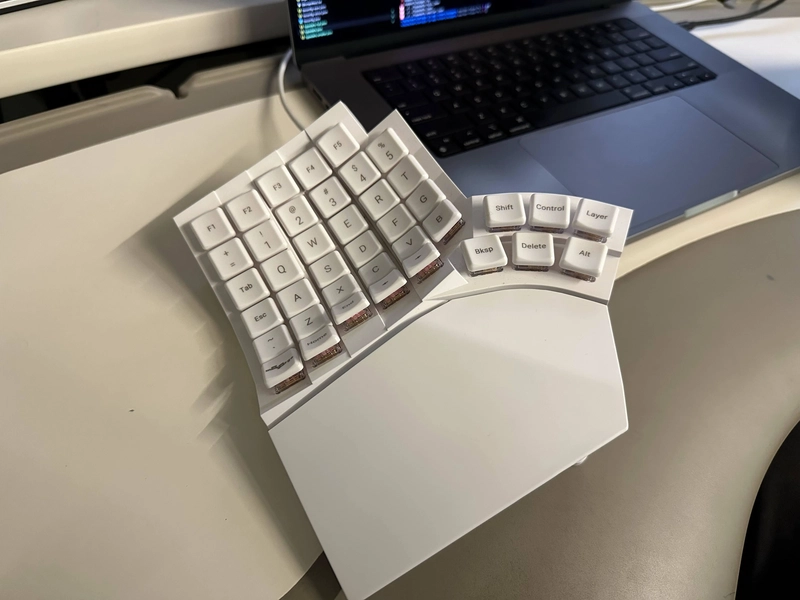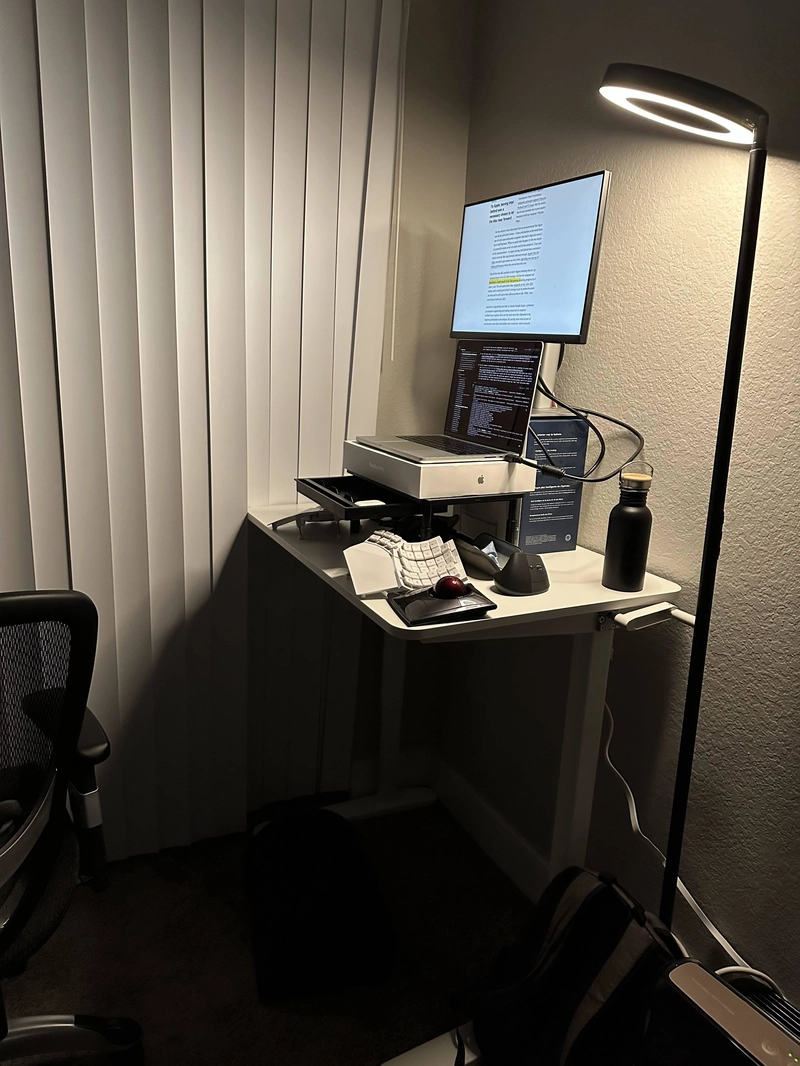My Journey with RSI
A story about my experience with finger pain and how I overcame it. Every situation is different, but I hope this helps or informs you.
The first half of the post is a weekly account of the experience and my attempts to fix this bug. The second half is the solution I found and the lessons learned.
TLDR: If you want to jump straight to the climax and resolution, skip to The worst week – and the turning point (week 13)
The trigger
Trigger condition:
- Was walking to work in 7c winter mornings without wearing gloves or a jacket, followed by typing right afterward.
- At this time, I was writing 29 ESLint rules & accompanying tests (compared to regular coding, this involves more typing and fewer breaks for thinking).
- Typing for 9-12 hours a day, 7 days a week.
In retrospect, I should have seen it coming.
The start of pain (week 0)
The pain was focused at the base of the 4 fingers (flexor tendons). Thumbs were not affected at the start as standard keyboard underuses the thumbs, especially among keyboard shortcut users.
My personality means I do a lot of research and overthink. Everything I read about RSI was alarming. My career and hobby all involve typing, so not being able to do that seemed like a nightmare.
Literal entry from my journal at the time:
RSI seems very scary and career-threatening
My immediate mitigation steps based on what I read:
- purchased gloves and started warming up fingers with hot water
- pressed keys more lightly
- maxed out touchpad sensitivity to reduce finger movement
- took breaks. jumping jacks in the office are a great break (brings blood to the entire body, including fingers).
- started doing finger stretches and strengthening exercises
- considered switching to dvorak, and delved into the rabit hole of alt layouts (but did not at the end)
- optimized daily workflows to reduce typing:
- shortened calendar event names
- wrote less verbose code
- used more contractions in messages
- reduced open applications to reduce the need for switching between them
- reduced email workload via mass unsubscribe and filtering
All of the above changes were done in a single day. I felt proud to be so proactive – heard horror stories online of people ignoring RSI for years until they were literally unable to type at all. I was happy that I took so much action in literally the first week of the symptoms. Now, I was hoping that all these changes would make the pain go away.
The first signs of … nevermind, it did not get better (week 1)
The pain did not magically disappear – slowly but steadily, it got more prominent. At this point, I began fighting my workaholic tendencies and managed to take a few hours each day for movies and VR gaming while listening to favorite audiobooks. Not doing anything productive is hard, but I needed to give the fingers some break.
I also started doing finger stretches and strengthening exercises daily. Purchased a 1HP course of personalized exercises – the personalized part was the key reason – I wanted a time-efficient solution that would target the part of the finger that needed it most.
Not getting better (week 2)
Exercise did not seem to help, so I decided to do more of it! 1HP said it would take 4-5 weeks to see results, so I was motivated to continue.
Unlike previous weeks, where pain would only appear toward the end of the workday, I started feeling the pain even in the afternoon.
More exercise and more breaks (week 3)
Pain starts even in the morning.
Here I decided to do more full-body exercise – it helps me feel better, and brings blood to the fingers (helps with recovery), without overly stressing them. I do VR fitness, VR boxing, dancing, abs reps, freestyle swimming, yoga, burpies, or jumping jacks – whichever feels best on a given day. Full body exercise definitely reduced finger pain, at least temporarily, and I increased it to an hour per day. Combined with a fast walk 1hr per day (to and from work), I was feeling happy that I was improving my body and healing my fingers at the same time.
Started going to the office 5 days a week to get more walking. Worth mentioning that I only work half a day in the office (8am-2pm), followed by a walk back home, exercise, shower, dinner, and then remote work (4:30pm-9:30pm). This lengthy mid-day break is the favorite part of the day – I get a mental break, do typing break, listen to favorite audiobooks, do exercise, and then am ready to work again with renewed energy (while everyone else is off work, so I get fewer distractions).
Here, I began trying out voice typing. See my article on 7 less common computer input devices for more details. My accent makes this trickier, so I also began accent training for a few minutes daily.
Also, my left hand began to hurt more than the right, so I was typing with the right hand only.
Single hand experiments (week 4)
After typing with just my right hand for a week, I tried using my right hand again, and the pain returned immediately. Not cool.
Something gotta change (week 10)
For several weeks, I kept experimenting with typing with just one hand, or typing with just thumbs, while continuing exercises for fingers, full body exercises, and taking breaks. Did not work – it was steadily getting worse. This is when I took an entire weekend, morning till evening, for research.
Some changes:
- ordered Logitech Lift vertical mouse to use instead of a touchpad
- ordered a compression glove
- ordered a standing desk to get better ergonomics
- got software for controlling the mouse with a gamepad
- learned macOS Voice Control; tried out Talon but passed on it
- ordered an ergonomic split keyboard with low activation force
- $425 is pricy, but far cheaper than the productivity loss so far, or the price of any surgery.
- also, I was excited to geek out around its features
All of the above is covered in more detail in 7 less common computer input devices.
My orders arrived (week 11)
- The IKEA Relatera desk arrived – really like how smart the design is.
- Took a few hours to learn how to use a vertical mouse (from a long-time touchpad user), but afterward it was much faster than controlling the mouse cursor with a gamepad.
- Compression glove cut off blood flow at the base of the fingers too much – stopped wearing it.
The keyboard is here! (week 12)
I have been not typing at all for the last two weeks. That reduced finger pain a lot – I got occasional spasms once or twice a day, but otherwise good.
Finally, the ergonomic keyboard has arrived.
After an evening of setup and learning, I was able to type on it faster than using an on-screen keyboard with mouse/gamepad, so I tried switching to it full time right away.
Well, bad idea. I had high hopes after weeks of not typing. I was so excited for the keyboard that I went back to typing for 10+ hours the very next day – and felt the pain return later in the evening. Did not help that this period happened to be unusually cold in the office.
The weather forecast projected more cold, and my finger pain was back, so I decided to take a break from typing again for a few days. Explored GitHub Copilot and AI voice-controlled agents – they are cool, but still too early.
The worst week – and the turning point (week 13)
Despite not typing, the pain was getting worse.
I had two full days of nothing but meetings – I was not typing at all, just sitting. I was also taking hot water breaks and wearing gloves. Did finger exercise and neural glides. And yet, the pain was getting worse than ever before. At this point, even showering and eating became painful.
I took more measures:
- Started using a gamepad with feet to avoid using fingers at all. Then optimized that further by using an iPad with feet (iPad acted as a giant touchpad for the laptop).
- Done more learning of voice typing – at this point, I could use the computer with just feet and voice (but at 40% of usual productivity).
- Had a company ergonomics assessment – they did not find anything wrong with what I was doing. They said I already gone above and beyond with alternative computer input devices.
- Bought different compression gloves (Copper Compression) – they are more comfortable.
- Scheduled doctor appointment (but nearest slot was 3 months away).
This is the turning point in my journey. With ergonomic assessment not bearing any results, and doctor appointment so far away, I had to take matters into my own hands (pun).
An important point is that through this journey so far, I was scared of the finger pain and the worst-case consequences. But this week, I learned how to control my computer without using fingers at all – just voice and feet. And while 40% productivity is not great, this is the floor below which I will not fall regardless of how bad the finger pain gets (and voice control is advancing rapidly with AI).
This gave me comfort and allowed me to think more clearly about the situation.
The Way Out
At this point, I remembered an article I read a year ago, even before finger pain. My Personal Experience with RSI – by Josh W Comeau. The article mentions that while the original pain was likely caused by physical strain, the brain can learn to associate the pain with typing and reinforce the pain, even after the physical damage is gone.
This was such a lightbulb moment. I quickly began reading up on the subject. I read The Mindbody Prescription. The book talks about physical pain being caused by suppressed emotions. While that did not resonate with my situation, I continued to explore the field of mentally-induced physical pain.
The next book I read was The Way Out. This was it. This was it! The summary of the book is that initial physical pain can lead to stress and worry, which leads to the brain learning to associate worry with pain and reinforcing the pain in a bad feedback loop. The book then guides you through collecting evidence for pain being caused by the brain. My evidence sheet:
- The pain came back immediately after I started typing, even though I took a 3-week break.
- Afterward, I was not typing at all (but thinking about the pain more and more), and it got worse and worse.
- While the original pain was all at the base of the fingers, the new pain was all over the hand, and even moving outside the wrist. The pain sometimes would move around from minute to minute.
- The pain would migrate to the thumbs after a day of controlling the computer with a gamepad.
- The index finger would hurt after hours of using a mouse.
- Focusing on the pain made it worse. Merely thinking about it could cause a flare-up, and pain can move around as you think about it.
- At this point, merely imagining typing brought the pain – this is a dead giveaway that the brain is involved.
- The pain came back at a specific time of day or during specific activities (in my case, the pain got much worse the moment I lay down in the bed in the evening – not the moment before, and not if I merely lay on the floor).
- I had a lot of stress and anxiety about the finger pain and the long-term consequences of it on my career.
- I had mentally-induced physical reactions in the past – skin rashes, pimples, and acne caused by anxiety. My parents and grandparents also had a history of physical reactions to mental stress.
- I learned that too many finger-strengthening exercises can put more stress on already inflamed tendons. After learning this, strengthening exercises became painful – not before that.
Recovery
Armed with a solid evidence sheet, I felt far more confident that the pain was mental. I set out to:
- Do daily “somatic tracking” – a practice of calmly observing the pain, without worrying about it, and teaching the brain that the fingers are okay, the pain is an overreaction.
- I continued avoiding typing for the next 4 weeks as a precaution, just in case I was wrong, and to give myself more mental ammunition: “even if I am wrong about the cause, surely a 4 week break would give fingers time to heal”.
- I referenced the evidence sheet often, and re-read the book whenever doubts crept in.
And you know what? For the next few days, the pain almost halved each day. I felt in control. I also worked on more stress reduction and meditation. Journal entry:
productivity is now high enough that I am no longer worried. finger pain is even less
I had an entire week of 8+ mood, even 10/10 one day. Then had a week of vacation where I did not think about the fingers at all.
After the vacation, I slowly began getting back to typing. This time I took it very easy:
- Day 1: air typing (hovering fingers above the keyboard and thinking about typing)
- Day 2: typing for a minute
- Day 3: typing for 15 minutes
- Day 4: typing for 1 hour
- Day 5+: brought the keyboard to the office and used it in combination with voice typing
- Day 10+: phased out voice typing and other copping mechanisms.
And that was it – that was the last journal entry mentioning finger pain. I still had occasional flare-ups, and did re-read The Way Out to remind myself again, but the pain was pretty much gone.
At this point, it has been 4 months since the first signs of the pain. 4 months is way less than the years of pain some people endure. I am very grateful for my “overthinking” trait, as it led me to research the problem as soon as it appeared. I iterated on the solution constantly and explored many options.
Best of luck with your journey.
Lessons learned
- I was tracking daily mood levels throughout. Surprisingly, it rarely deviated from 8/10. Some bad experiences temporarily pushed it down to 7 or rarely 6, and few great days were 9, but it always went back to 8.
- While finger strengthening exercise is good in the long run, don’t do it when you are in pain, as you can overstress the tissues or make the brain associate exercise with pain. Be careful with it.
- I have hypermobile fingers – they naturally stretch far more than the average person, and I also worked throughout childhood on stretching them more. However, for people with hypermobility, as I learned, further finger stretching is discouraged as it can lead to instability in joints and pain.
- If typing becomes painful, you gain sudden clarity about how much non-essential you can cut out to prioritize the most important tasks. I unsubscribed from a lot of newsletters, set up email filters, cut needless meetings, shortened calendar event names, and configured calendar event name autocomplete (checkout my Calendar Plus extension for Google Calendar power users).
- Got outside the comfort zone by voice typing and began working on accent training. Also, learned the value of hopping on a quick video call instead of typing long messages back and forth.
- I learned a lot about ergonomics. This might be the most important outcome in the long term. Through better posture, an ergonomic keyboard, an ergonomic mouse, and a standing desk, I probably averted several future occupational injuries.
- I explored a lot of unique computer input devices I would have never tried before. Read my article on 7 less common computer input devices for more details.
- If you are still dealing with finger pain, I highly recommend trying out some devices mentioned, as they can let you get back to using the computer with less pain.
While I would not want to repeat the experience, I am extremely glad about the things I learned along the way. I came out stronger and more confident about my ability to deal with future challenges.



